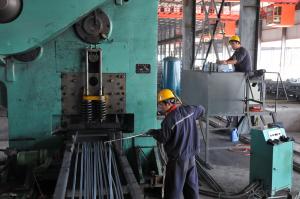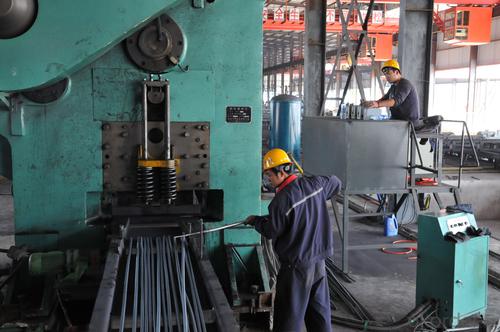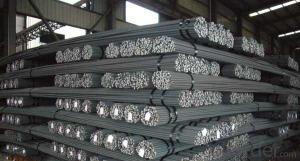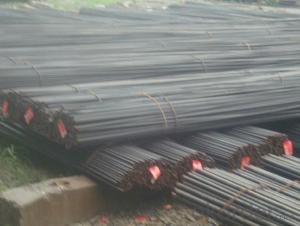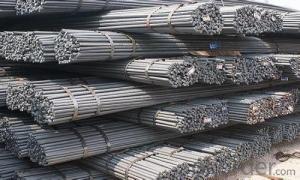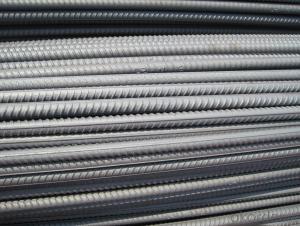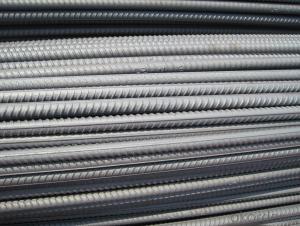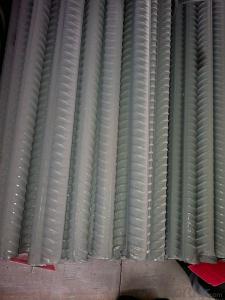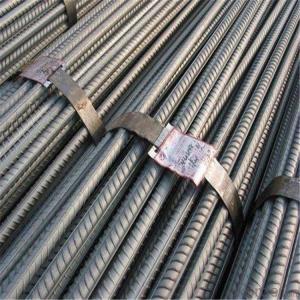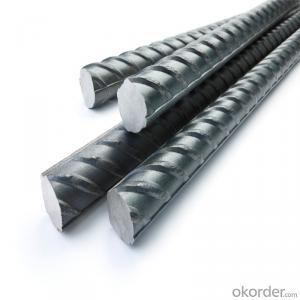Steel Deformed Rebar BS4449 GR460
- Loading Port:
- China Main Port
- Payment Terms:
- TT or LC
- Min Order Qty:
- -
- Supply Capability:
- -
OKorder Service Pledge
OKorder Financial Service
You Might Also Like
Product Description:
OKorder is offering Steel Deformed Rebar BS4449 GR460 at great prices with worldwide shipping. Our supplier is a world-class manufacturer of steel, with our products utilized the world over. OKorder annually supplies products to African, South American and Asian markets. We provide quotations within 24 hours of receiving an inquiry and guarantee competitive prices.
Product Applications:
Steel Deformed Rebar BS4449 GR460 are ideal for structural applications and are widely used in the construction of buildings and bridges, and the manufacturing, petrochemical, and transportation industries.
Product Advantages:
OKorder's Steel Deformed Rebar BS4449 GR460 are durable, strong, and wide variety of sizes.
Main Product Features:
· Premium quality
· Prompt delivery & seaworthy packing (30 days after receiving deposit)
· Can be recycled and reused
· Mill test certification
· Professional Service
· Competitive pricing
Product Specifications:
Manufacture: Hot rolled
Grade: Gr460
Size: 6mm-32mm
Certificates: ISO, SGS, BV, CIQ
Length: 6m – 12m, as per customer request
Packaging: Export packing, nude packing, bundled
| DEFORMED BAR | |
| SIZE d(mm) | theoretical kg/m |
| 6 | 0.222 |
| 8 | 0.395 |
| 10 | 0.617 |
| 12 | 0.888 |
| 14 | 1.21 |
| 16 | 1.58 |
| 18 | 2 |
| 20 | 2.47 |
| 22 | 2.98 |
| 25 | 3.85 |
| 28 | 4.83 |
| 32 | 6.31 |
FAQ:
Q1: Why buy Materials & Equipment from OKorder.com?
A1: All products offered byOKorder.com are carefully selected from China's most reliable manufacturing enterprises. Through its ISO certifications, OKorder.com adheres to the highest standards and a commitment to supply chain safety and customer satisfaction.
Q2: How many tons of steel products could be loaded in containers?
A2: Usually the steel products are delivered by bulk vessel because of the large quantity and the freight. However, there are no bulk vessel enter some seaports so that we have to deliver the cargo by containers. The 6m steel product can be loaded in 20FT container, but the quantity is changed according to the size, usually from 18tons to 25tons.
Q3: what is the difference between actual weight and theoretical weight?
A3: All the section steel has two weights: actual weight and theoretical weight. Actual weight is the weighing out when the product delivered from the mill. Theoretical weight is calculated by pieces. The invoice can be based on each of them as your request.
Images:
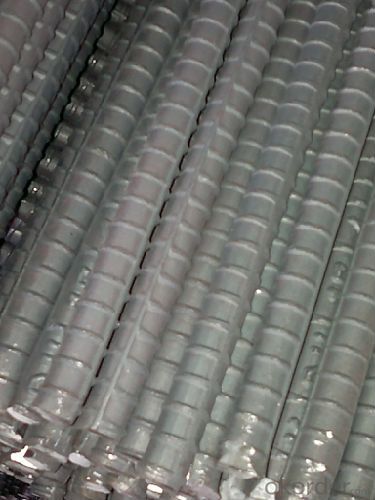
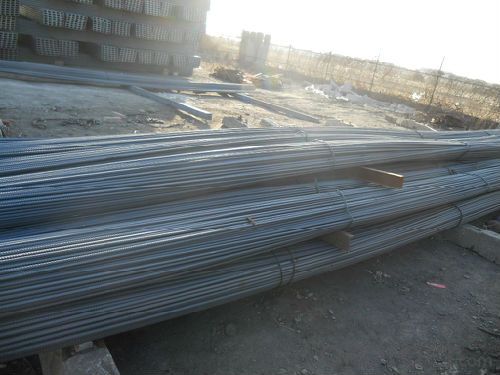
- Q: What are the different types of steel rebars used in road construction?
- There are typically two types of steel rebars used in road construction: plain steel bars and deformed steel bars. Plain steel bars are smooth and have no ridges or deformations. Deformed steel bars, on the other hand, have ridges, protrusions, or other patterns on their surface to improve the bond strength between the rebar and the surrounding concrete. Both types of rebars are commonly used in road construction to reinforce and strengthen the concrete structures.
- Q: Can steel rebars be used in offshore platform construction?
- Yes, steel rebars can be used in offshore platform construction. Steel rebars are commonly used in the construction of offshore platforms due to their high strength and durability, which is essential for withstanding harsh environmental conditions, including strong waves, corrosive saltwater, and extreme temperatures. Additionally, steel rebars can provide structural reinforcement, ensuring the stability and integrity of the offshore platform throughout its lifespan.
- Q: What are the precautions to be taken while welding steel rebars?
- When welding steel rebars, there are several precautions that need to be taken. First and foremost, it is crucial to wear appropriate personal protective equipment such as a welding helmet, gloves, and a protective apron to shield against sparks, heat, and UV radiation. Additionally, proper ventilation in the work area is necessary to prevent the accumulation of harmful fumes and gases. It is important to ensure that the rebar is clean and free from any contaminants or coatings that could affect the quality of the weld. Welding should only be performed by trained and qualified individuals who understand the specific techniques and settings required for welding rebars. Finally, regular inspections of the welds should be conducted to ensure their integrity and strength.
- Q: What is the difference between deformed and plain steel rebars?
- Deformed steel rebars have ribs, lugs, or projections on their surface, which provide better bonding with concrete and enhance their overall strength and durability. On the other hand, plain steel rebars have a smooth surface without any additional features.
- Q: How do steel rebars perform in extreme temperature conditions?
- Steel rebars perform well in extreme temperature conditions due to their high thermal conductivity and low coefficient of thermal expansion. This means that they can efficiently transfer heat and resist deformation caused by temperature changes. In extremely high temperatures, steel rebars retain their strength and structural integrity. They have a high melting point and maintain their properties even in intense fire situations. This makes them ideal for reinforcing structures such as buildings, bridges, and tunnels, where fire resistance is crucial. In extremely low temperatures, steel rebars also perform admirably. Unlike some other materials, steel does not become brittle and lose its strength in cold conditions. This makes it suitable for use in cold climates and regions with frequent freeze-thaw cycles. Furthermore, steel rebars have excellent durability and can withstand extreme temperature fluctuations without significant degradation. They do not expand or contract excessively, which helps to maintain the stability and longevity of reinforced structures. However, it's important to note that extreme temperatures can still have some impact on steel rebars. In very high temperatures, steel may experience some thermal expansion, which can cause minor stresses in the surrounding concrete. Similarly, in very low temperatures, some contraction may occur, but these effects are usually minimal and well within acceptable limits. Overall, steel rebars are a reliable choice for reinforcing structures in extreme temperature conditions, as they offer excellent strength, durability, and fire resistance.
- Q: How do steel rebars contribute to the structural integrity of a building?
- The structural integrity of a building is greatly enhanced by steel rebars, which play a vital role in this regard. Rebars, also known as reinforcing bars, are typically made of steel and are used to provide strength and stability to concrete structures. They are embedded within the concrete to create a composite material capable of withstanding various forces and loads. To begin with, rebars aid in the distribution and transfer of loads across the structure. When external forces such as wind, earthquakes, or heavy loads act upon a building, the rebars act as reinforcements, absorbing and dispersing these forces. By spreading the load over a larger area, they prevent concentrated stress points that could potentially lead to structural failure. Furthermore, rebars help prevent cracks and fractures in the concrete. Although concrete is highly durable under compression, it is weak in tension. Steel rebars, with their high tensile strength, counteract this weakness by resisting the tensile forces that could cause the concrete to crack or fail. By reinforcing the concrete, rebars ensure that the structure remains intact and can withstand various stresses. Additionally, rebars increase the overall durability and lifespan of a building. By providing additional strength and stability, they reduce the likelihood of structural damage, ensuring that the building can endure over time. This is particularly crucial in areas prone to natural disasters, where the strength of a building can be a matter of life and death. Lastly, steel rebars contribute to the overall safety of a building. By reinforcing the structure, they enhance its ability to withstand extreme events such as earthquakes or heavy impacts. This not only protects the occupants of the building but also reduces the risk of collateral damage to surrounding structures. In conclusion, steel rebars are indispensable components in construction that significantly contribute to a building's structural integrity. Their ability to distribute loads, prevent cracks, increase durability, and enhance safety make them a crucial element in modern construction practices.
- Q: Can steel rebars be used in structures with high alkaline environments?
- Yes, steel rebars can be used in structures with high alkaline environments. Steel rebars are commonly used in concrete structures and are designed to withstand various environmental conditions, including high alkaline environments. However, it is essential to ensure that the appropriate type of steel rebar is selected to prevent corrosion and maintain structural integrity in such conditions.
- Q: What is the process of reinforcing existing concrete structures with steel rebars?
- Enhancing the strength and durability of existing concrete structures with steel rebars involves a series of steps. To begin, a thorough assessment of the concrete structure is conducted to determine its condition and identify areas in need of reinforcement. This involves inspecting the concrete for cracks, signs of degradation, or any other structural issues. Once the areas requiring reinforcement are identified, the next step is surface preparation. This involves cleaning the concrete surface to remove any loose debris, dirt, or contaminants that could hinder the bonding of the rebars with the concrete. Various methods, such as pressure washing or sandblasting, can be used for this purpose. Following surface preparation, the rebars are strategically placed within the concrete structure. The positioning and spacing of the rebars are crucial to ensure optimal reinforcement and structural integrity. This is typically accomplished by drilling holes or creating channels in the concrete where the rebars will be placed. Afterward, the rebars are inserted into the holes or channels, ensuring proper alignment and securing. The rebars are typically cut to the required length and bent into the desired shape to meet the specific reinforcement needs of the structure. Once the rebars are in place, they are anchored or secured to the existing concrete by various means. This can be achieved through the use of epoxy adhesive, mechanical anchors, or embedding the rebars into fresh concrete poured around them. Finally, the concrete is restored to its original condition, covering the rebars and creating a smooth and even surface. This may involve patching up any holes or channels created during the reinforcement process and finishing the surface to match the surrounding concrete. In conclusion, the process of reinforcing existing concrete structures with steel rebars necessitates careful planning, proper surface preparation, precise placement of rebars, secure anchoring, and appropriate finishing to achieve a strengthened and long-lasting structure.
- Q: Are there any alternative materials to steel rebars?
- Yes, there are alternative materials to steel rebars. Some examples include fiberglass, carbon fiber, and basalt rebar. These materials offer advantages such as higher strength-to-weight ratios, corrosion resistance, and better durability in certain environments. However, the selection of alternative materials depends on specific project requirements and cost considerations.
- Q: Cast-in-place with 10 mm reinforcement, a good layer or 8 mm double layer? Why?
- The plate near the gable should be equipped with double - layer reinforced wire mesh. Adding radial reinforcement at the corner of the wall. In the region where the temperature and shrinkage stress are greater, a double layer steel mesh should be installed.
Send your message to us
Steel Deformed Rebar BS4449 GR460
- Loading Port:
- China Main Port
- Payment Terms:
- TT or LC
- Min Order Qty:
- -
- Supply Capability:
- -
OKorder Service Pledge
OKorder Financial Service
Similar products
Hot products
Hot Searches
Related keywords
